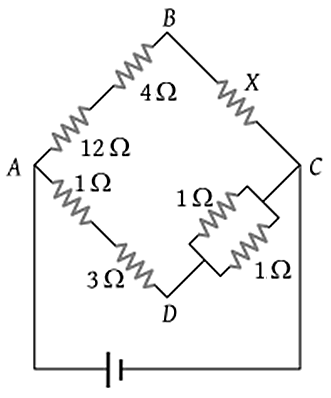In the circuit shown in the figure below, if the potential difference between \(B\) and \(D\) is zero, then value of the unknown resistance \(X\) is:

1.
\(4~\Omega\)
2.
\(2~\Omega\)
3.
\(3~\Omega\)
4.
EMF of a cell is required to find the value of \(X\)

The figure below shows a network of currents. The current \(i\) will be:

1. \(3~\text{A}\)
2. \(13~\text{A}\)
3. \(23~\text{A}\)
4. \(-3~\text{A}\)
The current in the given circuit is
(1) 0.1 A
(2) 0.2 A
(3) 0.3 A
(4) 0.4 A
Eels are able to generate current with biological cells called electroplaques. The electroplaques in an eel are arranged in \(100\) rows, each row stretching horizontally along the body of the fish containing \(5000\) electroplaques. The arrangement is suggestively shown below. Each electroplaques has an emf of \(0.15\) V and internal resistance of \(0.25~\Omega\).
The water surrounding the eel completes a circuit between the head and its tail. If the water surrounding it has a resistance of \(500~\Omega\), the current an eel can produce in water is about:
| 1. | \(1.5\) A | 2. | \(3.0\) A |
| 3. | \(15\) A | 4. | \(30\) A |
A potentiometer is an accurate and versatile device to make electrical measurement of EMF because the method involves
(1) cells
(2) potential gradients
(3) a condition of no current flow through the galvanometer
(4) a combination of cells, galvanometer, and resistances
The potential difference between points A and B in the given figure is if the current is flowing from A to B:
(1) - 3 V
(2) +3 V
(3) +6 V
(4) +9 V
A potentiometer wire is 100 cm long and a constant potential is maintained across it. Two cells are connected in series first to support one another and then in the opposite direction. The balance points are obtained at 50 cm and 10 cm from the positive end of the wire in the two cases. The ratio of emf is
1. 5:4 2. 3:4
3. 3:2 4. 5:1
The charge following through a resistance R varies with time where a and b are positive constants. The total heat produced in R is
(1)
(2)
(3)
(4)
A potentiometer wire has a length 4 m and resistance 8 Ω. The resistance that must be connected in series with the wire and an energy source of emf 2 V, so as to get a potential gradient 1 mV per cm of the wire is:
1. 32 Ω
2. 40 Ω
3. 44 Ω
4. 48 Ω
A, B, and C are voltmeters of resistance R, 1.5R, and 3R respectively as shown in the figure. When some potential difference is applied between X and Y, the voltmeter readings are VA, VB, and VC respectively. Then,
1. VA=VB=VC
2. VA≠VB=VC
3. VA=VB≠VC
4. VA≠VB≠VC










